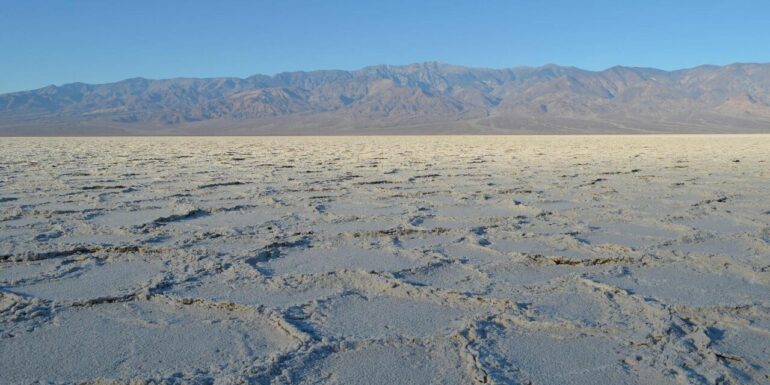Salt deserts are among the most extreme and inhospitable places on the planet and their bizarre and other-worldly polygon-shaped structures attract hundreds of thousands of tourists every year.
They occur in areas including the Badwater Basin of Death Valley in California and Salar de Uyuni in Chile, where they served as a backdrop for the desert planet Crait in “Star Wars: The Last Jedi.”
Now a team involving researchers at Nottingham Trent University and TU Graz in Austria has been able to explain the origin of these patterns and their iconic shape and size. The research is published in the journal Physical Review X.
Previously, it was suspected that the salt crust of the desert dries out and cracks form, around which the patterns grow. Another hypothesis suggested that the salt crust grows continuously and bends due to lack of space, forming the patterns.
Neither of these explanations, however, account for the consistent size—always one to two meters—and the honeycomb shape.
A more plausible explanation has now been provided by researchers, who describe how convection of saline water in the subsurface is responsible for the honeycomb-like formation of the salt patterns.
The constant size of the features and the speed with which the patterns grow can also be attributed to this, they say.
To get to the bottom of this mystery of nature, the team combined the research fields of fluid dynamics from physics and geomorphology from the geosciences and investigated the phenomenon from several directions.
They observed in laboratory experiments how saline water moves in sandy soils and analyzed in numerical simulations the length scale of the patterns under different conditions. In two field studies in California they observed the patterns in nature and collected samples to show that the currents in the subsurface mirror the patterns visible on the surface.
They were the first research group to record in a video how the salt pattern grows.
The evidence gathered by the researchers in experiments, simulations and field studies all points to a consistent picture.
The driving mechanism for pattern formation is the convection or circulation of salty water in the soil beneath the salt crust. The salt deserts in which these patterns occur are by no means bone dry and the highly salty groundwater often reaches up to lie directly below the salt crust. In these deserts you’d quickly reach that water digging by hand, although it would be far too salty to drink.
When this brine then evaporates in the hot summer sun, the salt remains. This makes the groundwater directly below the surface saltier, and thus heavier than the fresher water that still lurks below. If this difference in salinity is high enough, the saltier water near the surface begins to sink downwards, while fresher water rises from below.
Similar to hot and cold water circulating by convection in radiators, convection rolls of salty and less salty water form in the subsurface.
A single convection roll would have a circular shape, which maximizes the volume enclosed by the roll while minimizing its circumference. However, when many convection rolls develop next to each other in the ground, they are “squeezed” together and produce hexagonal, honeycomb-like patterns, along the edges of which very salty water sinks down.
In places with a particularly high salt content, salt also crystallizes more on the surface. Over time, the resulting crust forms the raised humps and edges that create the honeycomb salt pattern.
First author Dr. Jana Lasser from TU Graz said, “This is a great example of curiosity-driven basic research. Nature presents us with an obvious and fascinating puzzle that stimulates our curiosity and thereby prompts us to solve it—even without any direct further possibility of application in mind.”
In addition to satisfying curiosity, an understanding of the topography of salt deserts helps predict how much mineral-rich dust will be dislodged from the surfaces of salt deserts and swirled into the atmosphere. This dust in turn plays an important role in the formation of clouds and the transport of minerals into the oceans.
Dr. Lucas Goehring, Associate Professor in Physics in Nottingham Trent University’s School of Science and Technology, said, “In salt deserts the first thing you see—almost the only thing you see—is an endless patchwork of hexagons and other ordered shapes. Some 50 million tourists have visited these patterns at Death Valley alone, and the fantastic landscape demands an explanation.
“What we’ve shown is that a simple, plausible explanation is there, but hidden beneath the ground. The surface patterns reflect the slow overturning of salty water within the soil, a phenomenon somewhat like the convection cells that form in a thin layer of simmering water.
“Although beautiful, wind blowing over salt deserts is a major source of atmospheric dust, and our results will help understand processes like this in desert environments.”
The study also involved the Max Planck Institute for Dynamics and Self-Organization in Göttingen, the University of Southampton, the University of Leeds, the University of Göttingen and Oxford University.
More information:
Jana Lasser et al, Salt Polygons and Porous Media Convection, Physical Review X (2023). DOI: 10.1103/PhysRevX.13.011025
Why Death Valley Is Full of Polygons: physics.aps.org/articles/v16/31
Provided by
Nottingham Trent University
Citation:
The origin of the mysterious honeycomb patterns found in salt deserts around the world (2023, February 27)



